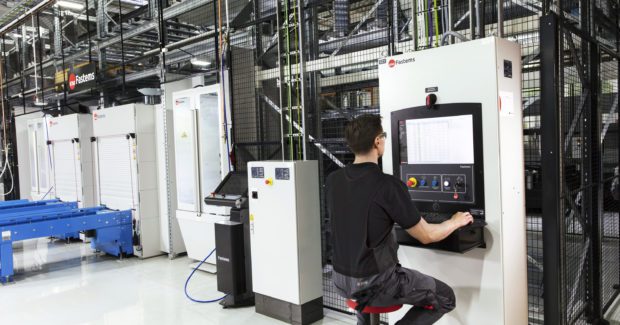Automation and Labor: Make it a Friendly Handshake
Employers may be able to search for people who may be less experienced in manufacturing but have good mechanical and computer skills. Digital savvy youth can be trained in one or a handful of roles as required.
Posted: February 2, 2022
Most of us in manufacturing understand how machining automation initiatives can help address the shortage of highly skilled individuals, and that it doesn’t necessarily mean “less” people. Note, I use the descriptor highly skilled. We still need people who possess shop skills, however, they can all have varying degrees of expertise and experience in shops that are embracing the automation philosophy. High-mix-low-volume shops applying the conventional “one person/one machine” approach have to employ what I often refer to as “superheroes.” Those are the highly skilled employees who know how to do literally everything to make a part, run a machine, and adapt to an often chaotic, ever-changing work environment. These are the rare individuals who are difficult to clone and find creating a gap. Automating machining operations can help mitigate that gap.
The most challenging aspect of introducing automation into a company is the culture change. Working for Fastems, I’ve had the pleasure and challenge of helping countless manufacturers navigate the automation journey, from automating one or two CNC machines, to multi-machine flexible manufacturing systems including supportive operations prior to or after the machining process, and everything in between. In each scenario, one very important aspect is often underestimated that can make the difference between a modest gain in productivity of 60 percent and a great gain of, for example, 95 percent spindle utilization. That all-important aspect is how the workplace culture change is presented, managed, incentivized and supported.
The change in working environment and culture is always a challenge and the decision-maker’s role is to make sure there is a full commitment to operate accordingly. To help ensure this, we always stress the importance of factual and frequent communication to everyone who will be involved with the new automated system. Better yet, the entire company should be included, if possible, to keep misinformation from circulating and undermining the automation effort. The best, most positive outcomes happen when we start having meetings with everyone at the initial planning phase so employees can immediately learn that the automation solution will lead to increased autonomy. In most cases automation will improve job security, safety, and interest, making it a successful implementation. Employees will understand why and how increasing productivity is important for them and their employer. Essentially, they become a stakeholder in the transition.
An example of incentivizing, one of our customers sets a certain weekly spindle utilization goal. If the goal is met, the staff gets a bonus in their next paychecks. By providing this reward much more frequently than the usual quarterly, semi-annual, or annual bonus model, the employees enjoy the progress from automation results and improvements. After a time, they see that automation’s benefit of increasing production capacity benefits all stakeholders. The company might even be growing to the extent that additional employees need to be hired. And, as a plus for the employer, the additional hires do not need to be “superheroes.”
With automation, employers may be able search for people who may be less experienced in manufacturing but have good mechanical and computer skills and can be trained in one or a handful of roles as required. They do not need to possess the conventional mastership surrounding every aspect of machining. As a case in point, one of our customers runs 25 machines tools in a very high-mix production environment where there is only one highly technical operator who is called the “troubleshooter.” This person alone manages all the machine tools per shift. There are additional operators loading parts to fixture, preparing raw materials, monitoring coolant and emptying chips, and managing the cutting tools. A lot of different roles are needed even if a system runs almost lights-out overnight.
Automation can also help with the challenge of attracting young people to manufacturing. They are computer savvy and can find smart factories interesting places to work. Workplaces with a lot of automation are generally cleaner and more pleasant workspaces to spend time in, too.
The topic of automation and labor go hand in hand, and it can be a friendly handshake if managed wisely right at the start of the culture change.
For more information go to www.fastems.com






